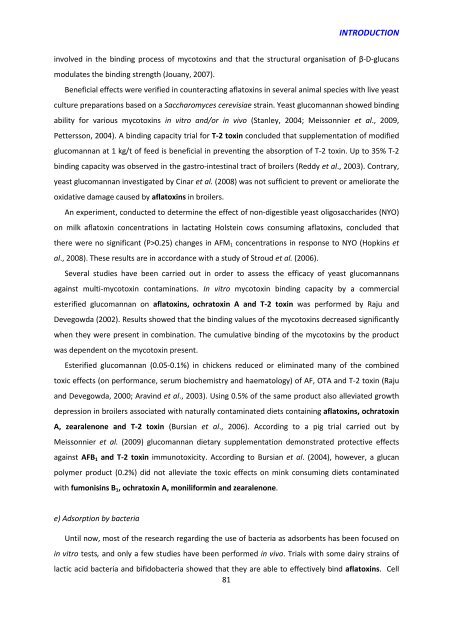Effet chez le porcelet d'une exposition à un régime co-contaminé en ...
Effet chez le porcelet d'une exposition à un régime co-contaminé en ...
Effet chez le porcelet d'une exposition à un régime co-contaminé en ...
Create successful ePaper yourself
Turn your PDF publications into a flip-book with our unique Google optimized e-Paper software.
INTRODUCTIONinvolved in the binding process of my<strong>co</strong>toxins and that the structural organisation of β-D-glucansmodulates the binding str<strong>en</strong>gth (Jouany, 2007).B<strong>en</strong>eficial effects were verified in <strong>co</strong><strong>un</strong>teracting aflatoxins in several animal species with live yeastculture preparations based on a Saccharomyces cerevisiae strain. Yeast glu<strong>co</strong>mannan showed bindingability for various my<strong>co</strong>toxins in vitro and/or in vivo (Stan<strong>le</strong>y, 2004; Meissonnier et al., 2009,Pettersson, 2004). A binding capacity trial for T-2 toxin <strong>co</strong>ncluded that supp<strong>le</strong>m<strong>en</strong>tation of modifiedglu<strong>co</strong>mannan at 1 kg/t of feed is b<strong>en</strong>eficial in prev<strong>en</strong>ting the absorption of T-2 toxin. Up to 35% T-2binding capacity was observed in the gastro-intestinal tract of broi<strong>le</strong>rs (Reddy et al., 2003). Contrary,yeast glu<strong>co</strong>mannan investigated by Cinar et al. (2008) was not suffici<strong>en</strong>t to prev<strong>en</strong>t or ameliorate theoxidative damage caused by aflatoxins in broi<strong>le</strong>rs.An experim<strong>en</strong>t, <strong>co</strong>nducted to determine the effect of non-digestib<strong>le</strong> yeast oligosaccharides (NYO)on milk aflatoxin <strong>co</strong>nc<strong>en</strong>trations in lactating Holstein <strong>co</strong>ws <strong>co</strong>nsuming aflatoxins, <strong>co</strong>ncluded thatthere were no significant (P>0.25) changes in AFM 1 <strong>co</strong>nc<strong>en</strong>trations in response to NYO (Hopkins etal., 2008). These results are in ac<strong>co</strong>rdance with a study of Stroud et al. (2006).Several studies have be<strong>en</strong> carried out in order to assess the efficacy of yeast glu<strong>co</strong>mannansagainst multi-my<strong>co</strong>toxin <strong>co</strong>ntaminations. In vitro my<strong>co</strong>toxin binding capacity by a <strong>co</strong>mmercia<strong>le</strong>sterified glu<strong>co</strong>mannan on aflatoxins, ochratoxin A and T-2 toxin was performed by Raju andDevegowda (2002). Results showed that the binding values of the my<strong>co</strong>toxins decreased significantlywh<strong>en</strong> they were pres<strong>en</strong>t in <strong>co</strong>mbination. The cumulative binding of the my<strong>co</strong>toxins by the productwas dep<strong>en</strong>d<strong>en</strong>t on the my<strong>co</strong>toxin pres<strong>en</strong>t.Esterified glu<strong>co</strong>mannan (0.05-0.1%) in chick<strong>en</strong>s reduced or eliminated many of the <strong>co</strong>mbinedtoxic effects (on performance, serum biochemistry and haematology) of AF, OTA and T-2 toxin (Rajuand Devegowda, 2000; Aravind et al., 2003). Using 0.5% of the same product also al<strong>le</strong>viated growthdepression in broi<strong>le</strong>rs associated with naturally <strong>co</strong>ntaminated diets <strong>co</strong>ntaining aflatoxins, ochratoxinA, zeara<strong>le</strong>none and T-2 toxin (Bursian et al., 2006). Ac<strong>co</strong>rding to a pig trial carried out byMeissonnier et al. (2009) glu<strong>co</strong>mannan dietary supp<strong>le</strong>m<strong>en</strong>tation demonstrated protective effectsagainst AFB 1 and T-2 toxin imm<strong>un</strong>otoxicity. Ac<strong>co</strong>rding to Bursian et al. (2004), however, a glucanpolymer product (0.2%) did not al<strong>le</strong>viate the toxic effects on mink <strong>co</strong>nsuming diets <strong>co</strong>ntaminatedwith fumonisins B 1 , ochratoxin A, moniliformin and zeara<strong>le</strong>none.e) Adsorption by bacteriaUntil now, most of the research regarding the use of bacteria as adsorb<strong>en</strong>ts has be<strong>en</strong> focused onin vitro tests, and only a few studies have be<strong>en</strong> performed in vivo. Trials with some dairy strains oflactic acid bacteria and bifidobacteria showed that they are ab<strong>le</strong> to effectively bind aflatoxins. Cell81

















